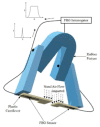Fiber Optic Sensors for Vital Signs Monitoring. A Review of Its Practicality in the Health Field
- PMID: 33672317
- PMCID: PMC7926559
- DOI: 10.3390/bios11020058
Fiber Optic Sensors for Vital Signs Monitoring. A Review of Its Practicality in the Health Field
Abstract
Vital signs not only reflect essential functions of the human body but also symptoms of a more serious problem within the anatomy; they are well used for physical monitoring, caloric expenditure, and performance before a possible symptom of a massive failure-a great variety of possibilities that together form a first line of basic diagnosis and follow-up on the health and general condition of a person. This review includes a brief theory about fiber optic sensors' operation and summarizes many research works carried out with them in which their operation and effectiveness are promoted to register some vital sign(s) as a possibility for their use in the medical, health care, and life support fields. The review presents methods and techniques to improve sensitivity in monitoring vital signs, such as the use of doping agents or coatings for optical fiber (OF) that provide stability and resistance to the external factors from which they must be protected in in vivo situations. It has been observed that most of these sensors work with single-mode optical fibers (SMF) in a spectral range of 1550 nm, while only some work in the visible spectrum (Vis); the vast majority, operate through fiber Bragg gratings (FBG), long-period fiber gratings (LPFG), and interferometers. These sensors have brought great advances to the measurement of vital signs, especially with regard to respiratory rate; however, many express the possibility of monitoring other vital signs through mathematical calculations, algorithms, or auxiliary devices. Their advantages due to miniaturization, immunity to electromagnetic interference, and the absence of a power source makes them truly desirable for everyday use at all times.
Keywords: biosensor; blood pressure; body temperature; fiber optic sensor; heart rate; human body; respiratory rate; vital signs.
Conflict of interest statement
The authors declare no conflict of interest.
Figures



















Similar articles
-
A Non-Invasive Multichannel Hybrid Fiber-Optic Sensor System for Vital Sign Monitoring.Sensors (Basel). 2017 Jan 8;17(1):111. doi: 10.3390/s17010111. Sensors (Basel). 2017. PMID: 28075341 Free PMC article.
-
Feasibility of fiber Bragg grating and long-period fiber grating sensors under different environmental conditions.Sensors (Basel). 2010;10(11):10105-27. doi: 10.3390/s101110105. Epub 2010 Nov 10. Sensors (Basel). 2010. PMID: 22163460 Free PMC article.
-
Magnetic Resonance Imaging Compatible Non-Invasive Fibre-Optic Sensors Based on the Bragg Gratings and Interferometers in the Application of Monitoring Heart and Respiration Rate of the Human Body: A Comparative Study.Sensors (Basel). 2018 Oct 31;18(11):3713. doi: 10.3390/s18113713. Sensors (Basel). 2018. PMID: 30384506 Free PMC article.
-
A Review of Wearable Optical Fiber Sensors for Rehabilitation Monitoring.Sensors (Basel). 2024 Jun 3;24(11):3602. doi: 10.3390/s24113602. Sensors (Basel). 2024. PMID: 38894393 Free PMC article. Review.
-
Fiber-Optic Chemical Sensors and Fiber-Optic Bio-Sensors.Sensors (Basel). 2015 Sep 30;15(10):25208-59. doi: 10.3390/s151025208. Sensors (Basel). 2015. PMID: 26437407 Free PMC article. Review.
Cited by
-
Photonic Integrated Interrogator for Monitoring the Patient Condition during MRI Diagnosis.Sensors (Basel). 2021 Jun 21;21(12):4238. doi: 10.3390/s21124238. Sensors (Basel). 2021. PMID: 34205594 Free PMC article.
-
Intrarenal pressure detection during flexible ureteroscopy with fiber optic pressure sensor system in porcine model.Sci Rep. 2024 Apr 24;14(1):9446. doi: 10.1038/s41598-024-60080-z. Sci Rep. 2024. PMID: 38658694 Free PMC article.
-
A Soft and Skin-Interfaced Smart Patch Based on Fiber Optics for Cardiorespiratory Monitoring.Biosensors (Basel). 2022 May 26;12(6):363. doi: 10.3390/bios12060363. Biosensors (Basel). 2022. PMID: 35735511 Free PMC article.
-
Recent Advances in Biomedical Photonic Sensors: A Focus on Optical-Fibre-Based Sensing.Sensors (Basel). 2021 Sep 28;21(19):6469. doi: 10.3390/s21196469. Sensors (Basel). 2021. PMID: 34640788 Free PMC article. Review.
-
U-Shaped Optical Fiber Probes Coated with Electrically Doped GQDs for Humidity Measurements.Polymers (Basel). 2021 Aug 12;13(16):2696. doi: 10.3390/polym13162696. Polymers (Basel). 2021. PMID: 34451236 Free PMC article.
References
-
- Pinet É. Medical Applications: Saving Lives. Nat. Photonics. 2008;2:150–153. doi: 10.1038/nphoton.2008.19. - DOI
-
- Güemes J.A., Sierra-Pérez J. Fiber Optics Sensors. In: Ostachowicz W., Güemes J.A., editors. New Trends in Structural Health Monitoring. Volume 542. Springer; Vienna, Austria: 2013. pp. 265–316. CISM International Centre for Mechanical Sciences.
Publication types
MeSH terms
LinkOut - more resources
Full Text Sources
Other Literature Sources
Research Materials

